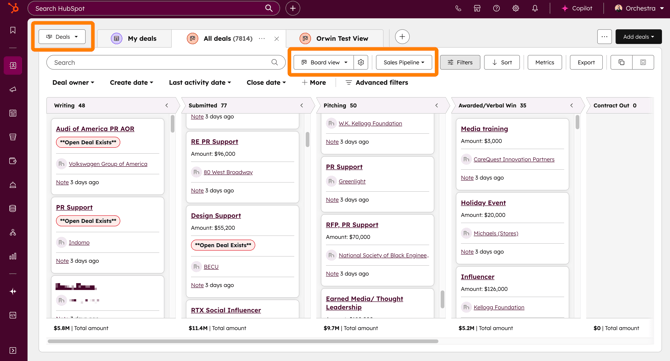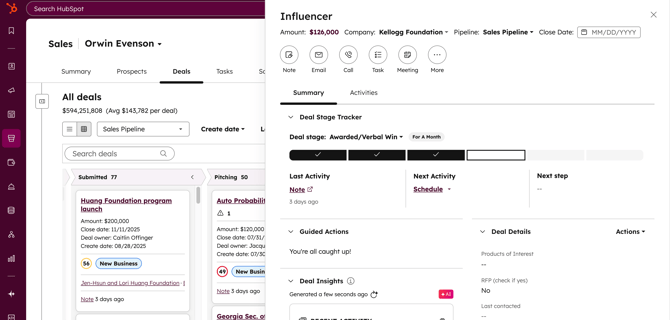Understanding the Sales Pipeline
Track qualified opportunities in Orchestra’s Sales Pipeline—from proposals to contracts—and learn how to manage deals through to Closed Won (or Closed Lost).
The Sales Pipeline in HubSpot is where Orchestra manages fully qualified opportunities (called Deals). Once a lead is confirmed as viable (budget, timeline, decision-maker), it becomes a Deal and enters this pipeline. From here, it progresses through proposal, negotiation, contract, and close.
Sales Pipeline Stages
| Stage | Definition | Win Probability |
|---|---|---|
| Writing | Preparing proposal or RFP response. | 20% |
| Submitted |
Proposal delivered to prospect; awaiting their response. Line Item budgets are required to move a deal to this stage. If Line Item budgets are on the deal record, the deal will automatically be moved back to the previous stage. |
30% |
| Pitching |
Engaged in final proposal presentation or a competitive pitch process (even if that includes multiple presentations). Use this stage if you are negotiating scope and budget ahead of a final decision. |
40% |
| Awarded / Verbal Win |
Client verbally committed to timeline and budget; contract pending. If there is not a finalized timeline or budget, remain in Pitching. It is critical that we have near-final budget numbers for this stage. |
75% |
| Contract Out |
Legal agreement sent to client for signature. Finance approval is required to move a deal to Closed Won. |
95% |
| Closed Won |
Contract signed; deal is official. Only Client Finance can move deals to 100% won after confirming that the contract is signed and the deal details match |
100% |
| Closed Lost |
Opportunity lost Details about the loss reasons are required to close out a deal in this stage. See Closed Lost article for additional details. |
0% |
🚨 Win Probabilities are defaulted by stage so that we have consistency across all agencies and practices. In exceptional circumstances—for very large and complex opportunities—the Head of Growth can override these default probabilities.
Here's an example view of the Deals Pipeline from the Deals data object:

How Deals Move Through the Pipeline
-
Start at Writing
A deal begins here when Orchestra is preparing a proposal or response. -
Submit & Track
Move to Submitted once the proposal is delivered to the prospect. Use HubSpot to log dates and attachments. Budgets are required to submit a proposal.
👉 See Adding Budgets via Line Items for more details -
Pitch & Negotiate
If shortlisted, move to Pitching. capture discussions and decision-maker feedback as necessary. When moving to this stage, pitch presentation details are required. Please use the first scheduled pitch for reference. -
Verbal Wins (or wins provided via email)
Only move to Awarded/Verbal Win when both timeline and budget are confirmed verbally or via email. -
Contract Out
Only move to this stage when a contract has been sent for final signature by the client. All details including budget and timeline should be final. Only a member of Client Finance (or a Super Admin) can move a deal from Contract Out to Closed Won.
👉 See Finance Approval Checkpoint for more details -
Closed Won
Deal is officially signed and completed. Only Client Finance (or a Super Admin) can move a deal to this stage. Win details, including budgets and timelines will be confirmed here. -
Closed Lost
If not awarded, select the appropriate Lost Reason to track trends.
👉 See Logging Closed Lost Reasons for more details
Here's an example of a deal from the Sales Workspace, where you can see the deal's progress in the Deal Pipeline clearly:
📌 Declined vs. Closed Lost
It’s important to distinguish between Declined (in the Lead Pipeline) and Closed Lost (in the Sales Pipeline):
-
Declined → Used before a Deal is created. The opportunity is disqualified at the lead stage (e.g., no budget, not a fit).
-
Closed Lost → Used after a Deal exists in the Sales Pipeline but does not move forward to contract.
👉 If a record has already become a Deal, always use Closed Lost, not Declined.
👌 Sales Pipeline Best Practices
📎 Link key Deal Docs on the Deal record
Every new deal will have a pinned Note created (under the Activities tab) where you can paste links to Google Docs that your team is working on. This is mean to provide easy and quick access to the documents your team is collaborating on.
📋 Upload Key Documents as Attachments
Always upload the proposal document to the Deal record for visibility. Attachments can be made from the Attachments card on the right hand side of a deal record. PDFs and Word Docs from the client may be uploaded here for posterity.
🏦 Capture Budgets
Enter confirmed budgets in the required budget property. (Cross-link to Budget Setup article.)
📓 Use Notes & Activities
Don't be shy when it comes to making notes on the deal record. Try to log all conversations, negotiations, and client updates.
Why the Sales Pipeline Matters
-
Forecasting: Probability settings help Orchestra model revenue.
-
Accountability: Everyone can see deal status, proposals, and contracts in one place.
-
Strategy: Tracking win/loss reasons and budget details informs how we approach future opportunities.
📌 Next Step: Learn how to set up and track budgets in HubSpot (link to future article).
